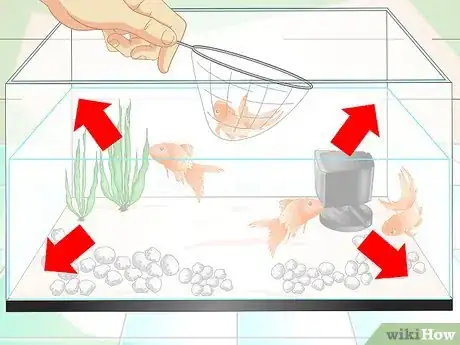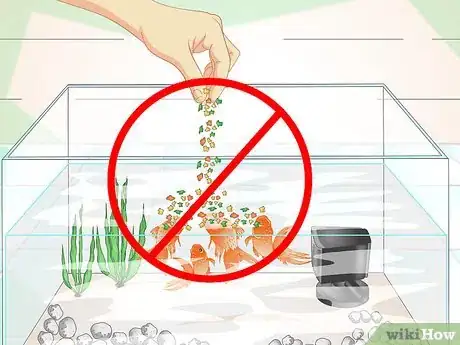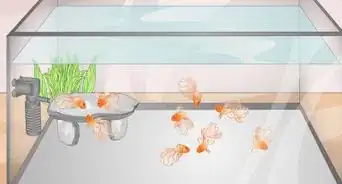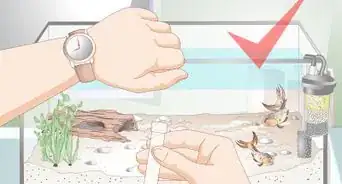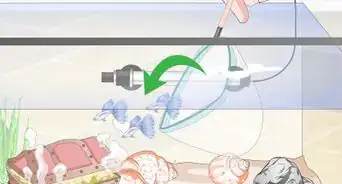This article was co-authored by Craig Morton. Craig Morton is the CEO of Aquarium Doctor Inc. based in Huntington Beach California and servicing Orange County, Los Angeles County, and the Inland Empire. With over 30 years of aquarium experience, Craig specializes in creating custom aquarium designs along with aquarium installation, service, and maintenance.
There are 9 references cited in this article, which can be found at the bottom of the page.
wikiHow marks an article as reader-approved once it receives enough positive feedback. This article received 13 testimonials and 100% of readers who voted found it helpful, earning it our reader-approved status.
This article has been viewed 218,669 times.
An aquarium with clear water is a sign of a healthy environment. Fish need clean and healthy water in order to thrive and live. Uneaten food, fish waste, and plant debris raise the ammonia, nitrite, and nitrate levels of the tank and make it unsafe. There are a number of ways for you to keep your aquarium water clear.
Steps
Setting Up Your Aquarium
-
1Leave the cloudy water. This is called "New Tank Syndrome", and sometimes will occur when a tank is recently set up. Many times cloudy water will disappear on its own while the water environment adjusts. Often, cloudy water is a result of a mixture of microscopic organisms, such as bacteria, protozoa, and micrometazoa. These organisms come from your fish, food, and waste. Usually, the tank will be balanced out and cleared up within around a week.
- Be patient. Before adding chemicals or trying to do anything drastic to fix the cloudy water, remember that the aquarium is full of living organisms. Figure out why the water might have become cloudy before doing anything to the water. Adding unnecessary chemicals and cleaners can upset your tank environment and harm your fish.
-
2Add in good bacteria. Adding in good bacteria helps the natural processes of the tank. You can get good bacteria in the tank in a couple of ways. You can buy prepackaged bacteria from the store or buy gravel that has the bacteria already on it. You can also add gravel, rocks, driftwood, or a filter pad from an established tank to your own tank. It will have the bacteria on it.
- Bacteria cultures will help to eliminate ammonia and nitrite, which are toxins. It changes them into less harmful nitrate, which is then removed during water changes.[1] The best bacterial species to do so are Nitrosomonas and Nitrobacter.[2]
- To keep bacteria in the tank, avoid replacing the filter cartridges. Instead, wash the cartridges in old tank water.
Advertisement -
3Place suitable live plants in the tank. Another way you can help keep your tank clean is by adding live plants. Live plants will help reduce nitrate levels. You can buy these at your local pet store.
-
4Determine if you have the correct filter. There are different filters that do different things for your fish. Cloudy water might be due to having the wrong filter. The filter you choose depends on the density of fish, the type of aquarium you have, and the use of live plants or artificial plants.
- There are three different filters to choose from. Mechanical filters remove the particles by forcing the water through a material that catches the particles. Biological filters use bacteria to change toxins into less toxic substances. Chemical filters use chemicals to remove toxins or chemical from the water. Some filters use two or all of these methods.
- Get the most powerful filter you can, but keep in mind that some fish such as bettas and hatchetfish won't tolerate a high flowing filter.
-
5Stock your tank thoughtfully. When you are putting fish in the tank, don’t place too many in it. This can cause health problems and make your tank harder to clean. For goldfish a good rule of thumb is twenty gallons for the first fish and ten for every fish you add. Do research on the types of fish you want to get to determine what size tank they need. [3]
Maintaining Your Aquarium
-
1Change the water. A good rule of thumb is to change 20% of the water in the tank every week.[4] If you use tap water, let it sit for two days after adding dechlorinator. This allows it to reach room temperature and let the pH settle, which helps the water not shock the fish when it is poured into the tank. [5] The dechlorinator removes chlorine to minimize stress. You can also add a stress coat to the water, which can prevent diseases in fish.
- You can also buy a device that hooks to your faucet that vacuums the gravel while removing and replacing water. You don’t have to wait a few days if doing it this way. Just make sure you make sure the temperature is close to your tank’s temperature and that you add in a chlorine remover.
-
2Keep your filter clean. You must keep your filter up and running. The filter helps keep your tank healthy and prosperous, so neglecting it can lead to cloudy water or even fish death. Read the instructions for your filter to know how to take care of it.
- All filters need to be examined weekly. Check them weekly for any blockages or build up. Clean as needed.
- When cleaning the cartridges, use tweezers to remove fish waste or other blockage. Do not rinse the cartridges, as this removes bacteria that lowers the ammonia and nitrites. The bacteria will look brown when it grows on the filter.
- Read the instruction manual that came with your pump to make certain it is properly installed and working as it should. The pump is important in aerating the aquarium with oxygen from the air. If it is not working properly the fish will suffer especially if the water is cloudy from waste matter.
Troubleshooting Cloudy Water
-
1Look for bacterial blooms. After changes to your fish tank, such as a large water change, a thorough cleaning, or medicating your fish, a bacteria bloom can occur. If this describes what led to the cloudiness in your tank, then be patient. The bacteria will balance out in a few days, and the water should clear on its own.[6]
-
2Check your filters. If your filters are not working properly, then the water can become cloudy. There is bacteria in your filtration system that consumes byproducts like ammonia and keeps things clean. If the filters stop working, the bacteria can build up in the water, making it look cloudy.[7]
-
3Adjust for additional fish. If you had recently added new fish to your aquarium, make sure the tank set up can handle the additional fish. For example, if you just added a larger fish to a tank that had smaller fish, it might be too much for the filtration system. Add a different filtration system, or lessen the amount of fish in your tank.[8]
-
4Refrain from overfeeding your fish. Overfeeding your fish can cause cloudiness in the water. Fish need to be fed sparingly. Feed them an amount of food once a day the size of their eye, and give them one or two fast days a week.[9]
-
5Be mindful with decorations. Sometimes, cloudiness can be caused by decorations. Make sure to wash all decorations carefully before adding them to the tank. Check all decorations in your tank to make sure they are designed for aquariums and purchased at good pet stores.[10]
- Check for melting or misshapen decorations, softening or loosening decorations, or flaking paint or discolorations on decorations.
-
6Control algae. Toxic blue-green algae clings to the sides of the tanks and sometimes to the decorative items in the tank. A good time to scrape algae from the sides is right before you change the water. Use a soft plastic squeegee or a clean toothbrush to gently scrape the side, then rinse under water to clean before taking another swipe. Remove all the ornaments and scrub in the old tank water to prevent shock in your fish.[11]
- Make sure your tank doesn’t get too much light because that can cause algae growth. Don’t place your tank close to a window and only keep tank lights on for 8 to 10 hours a day.[12]
- It is important not to overfeed your fish, as leftover food can contribute to algae growth and an ammonia spike.
Expert Q&A
Did you know you can get expert answers for this article?
Unlock expert answers by supporting wikiHow
-
QuestionHow do I make my fish tank water crystal clear?
 Craig MortonCraig Morton is the CEO of Aquarium Doctor Inc. based in Huntington Beach California and servicing Orange County, Los Angeles County, and the Inland Empire. With over 30 years of aquarium experience, Craig specializes in creating custom aquarium designs along with aquarium installation, service, and maintenance.
Craig MortonCraig Morton is the CEO of Aquarium Doctor Inc. based in Huntington Beach California and servicing Orange County, Los Angeles County, and the Inland Empire. With over 30 years of aquarium experience, Craig specializes in creating custom aquarium designs along with aquarium installation, service, and maintenance.
Aquarium Specialist, Aquarium Doctor Inc.
-
QuestionHow can I make my aquarium decorations safe?
 Craig MortonCraig Morton is the CEO of Aquarium Doctor Inc. based in Huntington Beach California and servicing Orange County, Los Angeles County, and the Inland Empire. With over 30 years of aquarium experience, Craig specializes in creating custom aquarium designs along with aquarium installation, service, and maintenance.
Craig MortonCraig Morton is the CEO of Aquarium Doctor Inc. based in Huntington Beach California and servicing Orange County, Los Angeles County, and the Inland Empire. With over 30 years of aquarium experience, Craig specializes in creating custom aquarium designs along with aquarium installation, service, and maintenance.
Aquarium Specialist, Aquarium Doctor Inc.
-
QuestionHow do I know if I overfeed my fish?
 Craig MortonCraig Morton is the CEO of Aquarium Doctor Inc. based in Huntington Beach California and servicing Orange County, Los Angeles County, and the Inland Empire. With over 30 years of aquarium experience, Craig specializes in creating custom aquarium designs along with aquarium installation, service, and maintenance.
Craig MortonCraig Morton is the CEO of Aquarium Doctor Inc. based in Huntington Beach California and servicing Orange County, Los Angeles County, and the Inland Empire. With over 30 years of aquarium experience, Craig specializes in creating custom aquarium designs along with aquarium installation, service, and maintenance.
Aquarium Specialist, Aquarium Doctor Inc.
References
- ↑ http://www.marineland.com/Guides/starting-an-aquarium-beginners.aspx
- ↑ http://www.bioconlabs.com/nitribactfacts
- ↑ http://www.firsttankguide.net/cloudywater.php
- ↑ Craig Morton. Aquarium Specialist, Aquarium Doctor Inc.. Expert Interview. 21 July 2020.
- ↑ http://www.thetropicaltank.co.uk/wchanges.htm
- ↑ http://www.fishtanktutor.com/how-to-get-rid-of-white-cloudy-aquarium-water
- ↑ http://www.oscarfishlover.com/cloudy-aquarium-water
- ↑ http://www.oscarfishlover.com/cloudy-aquarium-water
- ↑ Craig Morton. Aquarium Specialist, Aquarium Doctor Inc.. Expert Interview. 21 July 2020.
- ↑ Craig Morton. Aquarium Specialist, Aquarium Doctor Inc.. Expert Interview. 21 July 2020.
- ↑ http://www.firsttankguide.net/algae.php
- ↑ http://www.pets4homes.co.uk/pet-advice/tips-on-keeping-fish-tank-water-crystal-clear.html
About This Article
To keep your aquarium water clear, change out about 20% of the water in the tank every week. If you use tap water, let it sit for two days so the chlorine can dissipate and the water can reach room temperature, otherwise, it may shock the fish. Check your water filter at least once a week for blockages, and clean or replace it once a month. Live plants may also help keep the water in your tank clear. Read on for advice from our veterinary reviewer on adding beneficial bacteria to your tank!










